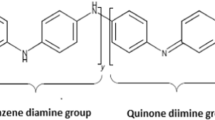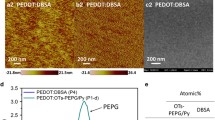Abstract
Polypyrrole doped with dodecylbenzenesulfonic acid (PPy.DBSA) was synthesized. The solubility parameters were calculated, the most suitable solvent (chloroform) was chosen for the solubility and the most compatible polymer [poly(methyl methacrylate), PMMA] was selected for blending. Hydroquinone was used as a compatibilizer to maximize the miscibility of PPy.DBSA with PMMA, which facilitated easy processing of flexible and mechanically strong conductive PPy films for device applications. Electrical properties of PPy.DBSA-PMMA blends were studied in the presence of hydroquinone. Flexible and free standing films with different compositions of PPy.DBSA in PMMA were cast onto glass substrates. Optical micrographs showed a low level of phase separation in the presence of hydroquinone. Thermal events under DSC analysis showed temperature shifts relative to those of the pure polymers, supporting the evidence for attractive interactions between the polymers.







Similar content being viewed by others
References
H.L. Wang, J.E. Fernandez, Macromolecules 25, 6179–6182 (1992)
B. Scrosati, Science and Applications of Conducting Polymers (Chapman and Hall, London, 1993)
K. Anuar, S. Murali, A. Fariz, H.N.M.M. Ekramul, Mater. Sci. 10, 255–258 (2004)
C.L. Helsey, J.P. Wightman, E.H. Pittaman, H.H. Kuhn, Text. Res. 63, 247 (1993)
P.J.S. Foot, A.B. Kaiser, Conducting Polymers, Kirk-Othmer encyclopedia of chemical technology (John Wiley and Sons Inc, New York, 2004)
J. Laska, K. Zak, A. Pron, Synth. Met. 84, 117–125 (1997)
K.S. Jang, H. Lee, B. Moon, Synth. Met. 143, 289–294 (2004)
M.K. Song, Y.T. Kim, B.S. Kim, J. Kim, K. Char, H.W. Rhee, Synth. Met. 141, 315–319 (2004)
G. Jiang, M. Gilbert, D.J. Hitt, G.D. Wilcox, K. Balasubramanian, Compos. Part A Appl. Sci. 75, 677–684 (2002)
M. Compos, F.R. Simon, E.C. Pereira, Sens. Actuators B 125, 158–166 (2007)
S.M. Asharaf, S. Ahmad, U. Riaz, J. Appl. Polym. Sci. 93, 82–91 (2004)
P. Dutta, S.K. De, Synth. Met. 139, 201–206 (2003)
M.L. Abel, M.M. Chehimi, F. Fricker, M. Delmar, A.M. Brown, J.F. Watts, J. Chromatogr. A 969, 273–285 (2002)
S. Yang, E. Ruckenstein, Synth. Met. 59, 1 (1993)
E. Ruckenstein, S. Yang, Polymer 34, 4655 (1993)
A. Rudin, The Elements of Polymer Science and Engineering, chapter 12, 1st edn. p. 437
D. Stauffer, Introduction to Percolation Theory (Taylor and Francis, London, 1985)
R. Zallen, The Physics of Amorphous Solids (Wiley, New York, 1983)
N.F. Mott, E. Davis, Electronic Process in Noncrystalline Materials (Clarendon, Oxford, 1979)
Z. Ding, J.T. Kloprogge, R.L. Frost, G.Q. Lu, H.Y. Zhu, J. Porous Mater. 8, 273–293 (2001)
Acknowledgments
The authors are grateful to Dr. Simon De Mars for the thermal analysis and to Mr. Richard Giddens for running the SEM, and they gratefully acknowledge the financial support from the Higher Education Commission (HEC), Pakistan, International Research Support Initiative Program (IRSIP).
Author information
Authors and Affiliations
Corresponding author
Rights and permissions
About this article
Cite this article
Shakoor, A., Foot, P.J.S. & Rizvi, T.Z. Conductive poly(methyl methacrylate)-polypyrrole dodecylbenzenesulfonate (PMMA-PPy.DBSA) blends prepared in solution in the presence of hydroquinone. J Mater Sci: Mater Electron 21, 1270–1276 (2010). https://doi.org/10.1007/s10854-010-0060-8
Received:
Accepted:
Published:
Issue Date:
DOI: https://doi.org/10.1007/s10854-010-0060-8




